Crossbuck
A crossbuck is a sign composed of two slats of wood or metal of equal length, fastened together on a pole in a saltire formation (resembling the letter X). Crossbucks usually are a traffic sign to indicate level railway crossings, sometimes supplemented by electrical warnings of flashing lights, a bell, or a gate that descends to block the road and prevent traffic from crossing the tracks.
Variants

In the United States, the crossbuck carries the words "RAIL" and "ROAD" on one arm and "CROSSING" on the other ("RAIL" and "ROAD" are separated by the "CROSSING" arm), in black text on a white background. Older variants simply used black and white paint; newer installations use a reflective white material with non-reflective lettering. Some antique U.S. crossbucks were painted in other color schemes, and used glass "cat's eye" reflectors on the letters to make them stand out. Other countries, such as China, also use this layout, but with appropriately localized terms. Often, a supplemental sign below the crossbuck indicates the number of tracks at the crossing.
A special kind of crossing sign assembly was introduced on an experimental basis in Ohio in 1992, the "Buckeye Crossbuck". It includes an enhanced crossbuck, reflective and with red lettering, and also a reflective plate reading "YIELD" below the crossbuck, whose sides are bent backwards in order to catch and reflect at a right angle the light of an approaching train. The experiment's final report gave the device a favorable review.[1] However, the plate was rejected for inclusion in the 2003 Manual on Uniform Traffic Control Devices.[2]
In Canada, crossbucks have a red border and no lettering. These were installed in the 1980s shortly after English-French bilingualism was made official, replacing signs of a style similar to those used in the U.S., except the word "RAILWAY" was used instead of "RAILROAD".
In Mexico, the crossbucks read "CRUCERO FERROCARRIL", a literal translation of its U.S. counterpart. Older designs read "CUIDADO CON EL TREN", meaning "beware of the train". In Argentina, the most common legend is "PELIGRO FERROCARRIL" ("danger: railroad"). Earlier crosses also read "CUIDADO CON LOS TRENES - PARE MIRE ESCUCHE ("beware of the trains - stop, look, listen")
In parts of Europe, the cross is white with red trimmings or ends, sometimes on a rectangular background; in Finland and Slovenia the cross is yellow, trimmed with red.
Taiwan uses two crossbucks. A version with a yellow and black cross, and one with the cross in white with a red border. A special symbol in the center indicates an electric railroad crossing, cautioning road users about excessive height cargo that may contact the electric wires.
In Australia, the crossbuck is a St Andrews Cross as in Europe, but uses words and the same color as the American crossbuck. In contrast to the American "RAILROAD CROSSING", Australian signs say "RAILWAY CROSSING" or "TRAMWAY CROSSING". (Most cases where a tram in its own right-of-way crosses a road do not use a crossbuck and so are regular intersections rather than level crossings.)
Different countries may classify the sign differently. For example, in Australia it is considered a regulatory sign, while in close neighbour New Zealand it is considered a warning sign. Some countries, such as Australia, France, New Zealand, and Slovakia may place the crossbuck design on a "target board", while other countries quite often do not.
 Argentina
Argentina Australia
Australia Australia (with red target board)
Australia (with red target board) Belgium
Belgium.svg.png) Botswana
Botswana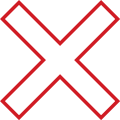 Canada
Canada Chile
Chile China
China Colombia
Colombia Denmark
Denmark Finland, Greece
Finland, Greece France
France Germany
Germany Germany (with danger of electrical wires overhead)
Germany (with danger of electrical wires overhead) Indonesia
Indonesia Italy
Italy.svg.png) Japan, Taiwan
Japan, Taiwan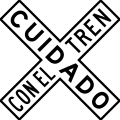 Mexico
Mexico Netherlands
Netherlands New Zealand
New Zealand New Zealand (with red target board)
New Zealand (with red target board) Norway
Norway Philippines
Philippines Philippines (with red target board)
Philippines (with red target board) Poland
Poland Russia, Belarus
Russia, Belarus Singapore
Singapore Slovakia
Slovakia South Korea
South Korea.svg.png) Sweden
Sweden Taiwan
Taiwan Taiwan (with danger of electrical wires overhead)
Taiwan (with danger of electrical wires overhead)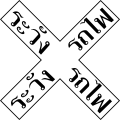 Thailand
Thailand United Kingdom
United Kingdom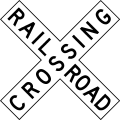 United States
United States.svg.png) Zambia, Zimbabwe
Zambia, Zimbabwe
Multiple tracks
Several countries use a sign to indicate that multiple tracks must be crossed at a level crossing. In Australia, Canada, New Zealand, and the U.S., a sign is mounted beneath the crossbuck (above the warning light assembly, if any) with the number of tracks. Many European countries use multiple crossbucks or additional chevrons ("half-crossbucks") below the first one. Taiwan also uses half-crossbucks below the regular crossbuck.
 Argentina
Argentina.svg.png) Australia
Australia.svg.png) Australia (with red target board)
Australia (with red target board) Austria
Austria Belgium
Belgium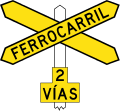 Chile
Chile Denmark
Denmark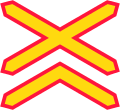 Finland, Greece
Finland, Greece France
France Indonesia
Indonesia Italy
Italy Netherlands
Netherlands.svg.png) New Zealand
New Zealand.svg.png) New Zealand (with red target board)
New Zealand (with red target board) Norway
Norway Poland
Poland Slovakia
Slovakia.svg.png) Sweden
Sweden Taiwan
Taiwan Taiwan (with danger of overhead electrical wires)
Taiwan (with danger of overhead electrical wires) United States
United States
Advance warning
Several countries include the crossbuck design in their advance warning signs for a railway crossing ahead.
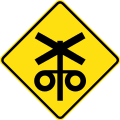 Australia
Australia.svg.png) Australia
Australia Australia (with warning lights)
Australia (with warning lights)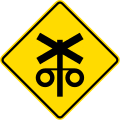 New Zealand
New Zealand United States
United States
References
| Wikimedia Commons has media related to Warning crosses. |
- ↑ Russ College of Engineering and Technology (December 2000). "Evaluation of the Buckeye Crossbuck at Public, Passive Railroad/Highway Grade Crossings in Ohio" (PDF). Ohio Department of Transportation. Retrieved 2009-11-04.
- ↑ "Manual on Uniform Traffic Control Devices - Part 8: Traffic Controls for Highway-Rail Grade Crossings". United States Federal Highway Administration. 2003. Archived from the original (PPT) on September 27, 2007. Retrieved 2007-12-06.
External links
- Part 8. Traffic Control for Railroad and Light Rail Transit Grade Crossings, U.S. Manual on Uniform Traffic Control Devices, 2009 ed.